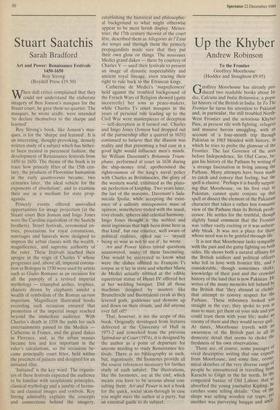Stuart Saatchis
Sarah Bradford
Art and Power: Renaissance Festivals 1450-1650 Roy Strong (Boydell Press £19.50) when dull critics complained that they could not understand the elaborate imagery. of Ben Jonson's masques for the Stuart court, he gave them no quarter. The masques. he wrote acidly, were intended 'to declare themselves to the sharpe and learned'.
Roy Strong's book, like Jonson's mas- ques. is for the 'sharpe and learned'. It is an interesting, thought-provoking, densely written study of a subject which has hither- to been treated in piecemeal fashion, the development of Renaissance festivals from 1450 to 1650. The theme of the book is to trace how princely fetes of the 15th cen- tury, the products of Florentine humanism in the early quattrocento became, two centuries later, 'the ideal vehicle for the exponents of absolutism', and to examine their use as a medium for state prop- aganda.
Princely events offered unrivalled opportunities for image projection (at the Stuart court Ben Jonson and Inigo Jones were the Caroline equivalent of the Saatchi brothers). Street festivals, ceremonial en- tries, processions for royal coronations, marriages and funerals were designed to impress the urban classes with the wealth, magnificence, and supreme authority of the ruler. These festivals reached their apogee in the reign of Charles V whose progresses and, above all, imperial corona- tion in Bologna in 1530 were used by artists such as Giulio Romano as an occasion for all the panoply of a revived imperial mythology — triumphal arches, trophies, chariots drawn by elephants amidst a wealth of symbolism of the Roman sacrum imperium. Magnificent illustrated books recording such occasions ensured that promotion of the imperial image reached beyond the immediate audience. With Charles's death in 1558 the palm for such entertainments passed to the Medicis Catherine in France, and the grand dukes in Florence, and, as the urban masses became less and less important in the ruler's calculations, so the occasions be- came principally court fetes, held within the precincts of palaces and designed for an initiated elite.
'Initiated' is the key word. The organis- ers of these festivals expected the audience to be familiar with neoplatonic principles, classical mythology and a jumble of herme- tic and classical images and symbols. Roy Strong admirably explains the concepts and connections behind the imagery,
establishing the historical and philosophic- al background to what might otherwise appear to be mere lavish display. Menes- trier, the 17th century theorist of the court fête, described them as Allegories de l'Estat des temps and through them the princely propagandists made sure that they put their own gloss on things. The nouveaux Medici grand dukes — there by courtesy of Charles V — used their festivals to present an image of dynastic respectability and ancient royal lineage, even tracing their right to rule back to the Etruscan kings.
Catherine de Medici's 'magnificences' held against the troubled background of the French Wars of Religion showed (quite incorrectly) her sons as peace-makers, while Charles I's court masques in the years of personal rule leading up to the Civil War were masterpieces of deception — self-deception as it turned out. Charles and Inigo Jones (Jonson had dropped out of the partnership after a quarrel in 1631) continued to believe that the illusion was reality and that presenting a bad case in a good light would influence men's minds. Sir William Davenant's Britannia Trium- phans, performed at court in 1638 during the ship-money trial, apotheosised the righteousness of the king's naval policy with Charles as Britannocles, the glory of the western world, exhibited as the plato- nic perfection of kingship. Two years later, the last of the masques, Davenant's Sala- micida Spolia, while accepting the exist- ence of a sullenly unresponsive mass of opinion, nonetheless ended with the usual, rosy clouds, spheres and celestial harmony. Inigo Jones thought it 'the noblest and most ingenious that hath been done here in that kind', but one courtier, well aware of political realities, opted out — 'myself
• being so wise as not to see it', he wrote.
Art and Power leaves trivial questions unanswered, many of them fascinating. One would be interested to know what were the dishes offered to Francois l's corpse as it lay in state and whether Marie de Medici actually nibbled at the edible equestrian statue of Henri IV offered her at her wedding banquet. Did all those machines designed by masters like Brunelleschi and Buontalenti creak as they levered gods, goddesses and demons up and down on their clouds, and did anyone ever fall off?
That, however, is not the scope of this book. Originally developed from lectures delivered at the University of Hull in 1971-2 and reworked from the previous Splendour at Court (1974), it is designed by the author as a point of departure for anyone needing to study Renaissance fes- tivals. There is no bibliography as such, but, ingeniously, the footnotes provide all the source references necessary for further study of each subject. The illustrations, like the footnotes, are at the end, which means you have to be serious about con- sulting them. Art and Power is not a hook for the quick, social skim-through in case you might meet the author at a party, but an essential guide to its subject.






































































 Previous page
Previous page